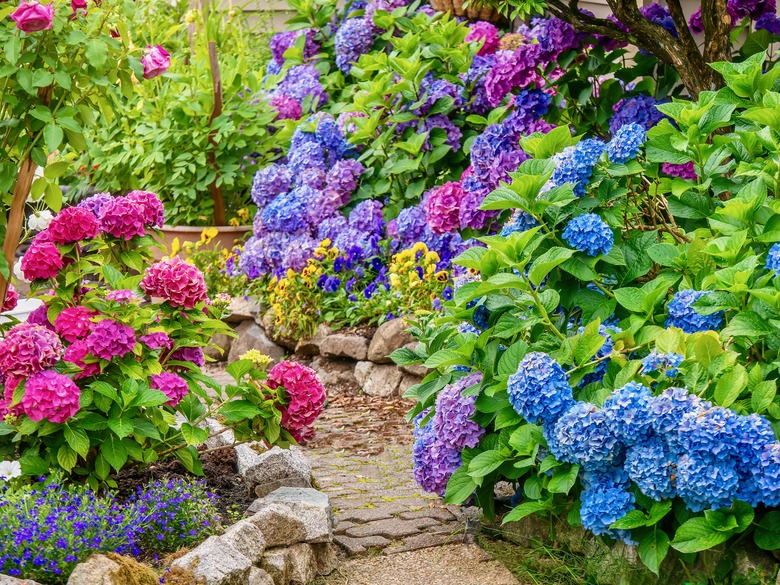How To Get Rid Of Flies On Flowering Bushes
We may receive a commission on purchases made from links.
Flies are gross, quite simply, but flies on flowering bushes are highly unlikely to be the kinds of flies attracted to manure or rotting materials. Rather, they may be flies actually called "flower flies," which are a type of fly that pollinates certain flowers. In most cases, flies on your bushes are harmless or even useful if they are pollinators, but if your yard seems to have attracted houseflies, try several deterrents, including plants that repel flies and controlling garbage or pet feces.
Getting Rid of Flies in Your Yard
Getting Rid of Flies in Your Yard
If you have flies in your yard or landing on your bushes, whether flowering or not, the first thing to do is to ensure that you are not unwittingly attracting them. Seal any garbage cans, clean up after your dog (and cat if they're not great at burying their waste), and if you are composting, make sure that you are not adding meat.
If you see them congregating in certain areas, try hanging old-fashioned flypaper sticky strips nearby. This can also help with fly identification so that you can know whether you have beneficial insects or pests.
Another option is to incorporate plants that repel flies. If whiteflies are your problem, plant marigolds (Tagates spp. USDA plant hardiness zones 2a to 11b), while lavender (Lavendula spp., USDA zones 5a to 9a) repels a wide range of insects, including mosquitoes, moths, fleas, and flies.
Treating flies using chemicals is generally not recommended because pesticides target adult flies, so fly species in larval development will just continue to plague you.
Plants That Attract Flies
Plants That Attract Flies
Some plants attract flies. A common succulent used to control erosion and create a dense ground cover, called either red apple, heartleaf ice plant, or baby sun rose (Aptenia cordifolia, USDA zones 9 to 10), has been discovered to attract canyon flies (Fannia benjamini complex); it is believed that these flies develop on the decaying understory of this prolific and invasive plant. If this is your plant, then you have canyon flies, and the best strategy is to dig up this plant and rid your yard of it.
Other plants that attract flies are jack-in-the-pulpit flowers (Arisaema triphyllum, USDA zones 4 to 9), which produce a fungal smell that fungus gnats can't get enough of. Pawpaw (Asimina triloba, zones 5 to 9) is another culprit due to its meat-colored petals and smell. Rounding out a fly's perfect meal is the skunk cabbage (Lysichiton camtschatcensis, USDA zones 5 to 7), which attracts carrion flies, which think that it is rotting flesh.
Beneficial Flies That Pollinate Flowers
Beneficial Flies That Pollinate Flowers
Some fly species are important pollinators. Most "flower flies," including multiple species in the Syrphidae family, mimic the look of bees. There are more than 900 species of these in North America, so your yard is highly likely to harbor some, although since they generally look and behave like bees (though they are not as hairy), they are unlikely to be offensive or to be categorized by home gardeners as flies. These flies are also known as hoverflies or syrphid flies, and they are effective at eradicating aphids as well as aiding in pollination.
Even the much-maligned blowfly, that common metallic blue/green pest, is potentially an aide in orchard pollination, according to recent studies in Australia reported in Smithsonian Magazine. Researchers found that flies are the most important pollinators after bees because even if they breed in rotting matter or manure, they still forage among flowers for nectar and protein-rich pollen. This is why some farmers in Australia are hanging rotting carcasses in their orchards or filling barrels with roadkill. This is probably not something you'll want to do in your home orchard, though!
References
- PennState Extension: Feeding the Flower Flies: How to Attract Flies to Your Garden
- Arizona Cooperative Extension: Fly Control
- University of California Statewide Integrated Pest Management Program: Pests of Homes, Structures, People, and Pets
- U.S. Forest Service: Fly Pollination
- Smithsonian: How Much Do Flies Help With Pollination?
- NC State Extension: Lavandula
- NC State Extension: Tagetes
